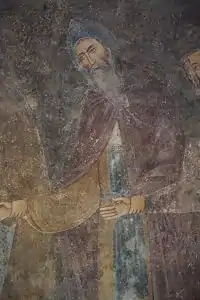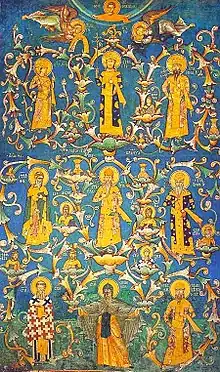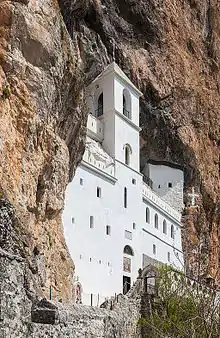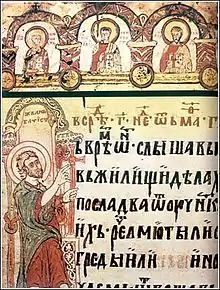Stefan the First-Crowned
Stefan Nemanjić (Serbian Cyrillic: Стефан Немањић, pronounced [stêfaːn němaɲitɕ]) or Stefan the First-Crowned (Serbian: Стефан Првовенчани / Stefan Prvovenčani, IPA: [stêfaːn prʋoʋěntʃaːniː]; around 1165 – 24 September 1228) was Grand Prince of Serbia from 1196, and the King of Serbia from 1217 until his death in 1228. He was the first Rascian king, and through his promotion of the Serbian Grand Principality into a kingdom and helping his brother Saint Sava in establishing the Serbian Church, he is regarded one of the most important of the Nemanjić dynasty.
| Stefan the First-Crowned | |
|---|---|
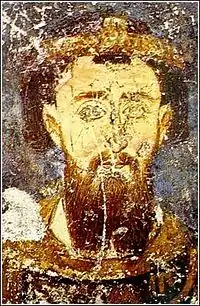 Fresco of Stefan the First-Crowned from Mileševa Monastery | |
| Reign | 1196–1228 |
| Coronation | 1217 (as king) |
| Predecessor | Stefan Nemanja |
| Successor | Stefan Radoslav |
| Born | around 1165 |
| Died | 24 September 1228 |
| Burial | |
| Spouse | Eudokia Angelina Anna Dandolo |
| Issue | Stefan Radoslav Stefan Vladislav Stefan Uroš I Sava II |
| House | Nemanjić dynasty |
| Father | Stefan Nemanja |
| Mother | Anastasija |
| Religion | Serbian Orthodox |
Early life
Stefan Nemanjić was the second-eldest son of Grand Prince Stefan Nemanja and Anastasija. His older brother and heir apparent, Vukan, ruled over Zeta and the neighbouring provinces (the highest appanage) while his younger brother Rastko (later known as Saint Sava) ruled over Hum.
The Byzantines attacked Serbia in 1191, raiding the banks of South Morava. Nemanja had a tactical advantage, and began to raid the Byzantine armies. Isaac II Angelos summoned a peace treaty, and the marriage of Nemanja's son Stefan to Eudokia Angelina, the niece of Isaac II, was confirmed. Stefan Nemanjić received the title of sebastokrator.
Conflict over succession
Throughout the 12th century, Serbs were at the center of war events between Byzantium and Hungary for dominance. In such circumstances, Serbs had no chance of gaining independence. Their only chance was to look for an ally on third side.
In 1190, the German Emperor Friedrich Barbarossa drowned in the river Calycadnus. At the same time, Emperor Isaac II Angelos launched a punitive expedition against the Serbs, and Nemanja was defeated in the battle of South Morava. In fact, Constantinople did not want to subdue the Serbs, but to regain Niš and the main road to Belgrade, as well as to make allies of the rebellious Serbs. The peace treaty provided for Stefan Nemanjić, the middle son of the grand zoupan Stefan Nemanja, to marry a Byzantine princess, i.e. nephew of the Byzantine emperor.
The concluded peace envisages that the grand zoupan Nemanja will be succeeded by his middle son Stefan, who received the Byzantine title of sebastokrator and the Byzantine princess Eudokia for a wife, and not the firstborn Vukan.
In 1196, at the state assembly near Church of Saints Peter and Paul, Stefan Nemanja abdicated the throne in favor of his middle son Stefan, who became the grand zoupan of Serbia. He left his eldest son Vukan in charge of Zeta, Travunija, Hvosno and Toplica. Nemanja became a monk in his old age and was given the name Simeon. Shortly afterwards, he went to Byzantium, to Mount Athos, where his youngest son Sava had been a monk for some time. They received permission from the Byzantine emperor to rebuild the abandoned Hilandar monastery.
The new Pope Innocent III, who in a letter in 1198 called on the entire West to liberate the Holy Land, was not satisfied with the fact that the Serbs were subordinated to the Patriarch of Constantinople, but wanted to return them to Rome through Vukan. In 1198, the Hungarian dux Andrew conquered Hum (Hercegovina) of grand zoupan Stefan and rebelled against brother king Emeric but did not gain legitimacy from Rome. In any case, the Hungarians became dominant on the eastern Adriatic coast. But Venice, because of its business interests, did not like the eastern coast of the Adriatic to be controlled by the mighty Byzantium or Hungary. Vukan and the Hungarian king Emeric (1196-1204) make an alliance against Stefan, after which a civil war breaks out in Serbia. The action against Stefan was preceded by his letter to the Pope in which he asked for the crown. Around 1200, Stefan was expelled his wife Eudokia, a daughter of Alexios III Angelos, who found refuge to Vukan in Zeta. Emeric saw Stefan's move as an open attack on his crown, because in Hungary it was traditionally believed that only she in the region could have primacy with the Roman pope. Stephen lost the conflicts and had to flee the country in 1202 to the Bulgarian-Kuman prince Kaloyan (prince 1196-1203; king 1204-1207).
In the meantime, control of the newly formed crusade army was taken over by the powerful Venetian doge Enrico Dandolo, who, to the surprise of all, including the pope himself, in the Fourth Crusade first sent an attack on Hungarian Zara in 1202, and then on Byzantium, whose capital Constantinople crusaders conquered in April 1204. Stefan uses this situation and in the counter-offensive, with the help of Prince Kaloyan, he returns to the throne in Ras in 1204, while Vukan retreats to Zeta. The fighting between the brothers was stopped in 1205 and relations were established as they were before the outbreak of the conflict. Meanwhile, in November 1204, the Hungarian king Emeric died and the Bulgarian prince Kaloyan was crowned for king.
Numerous states were created on the ruins of Byzantium, which were almost equal in strength. The Crusaders founded the Kingdom of Thessalonica, the principality of Achaia, the dutchy of Athens and Thebes, the dutchy of Archipelago or Naxos. They were all under rule of Latin emperor of Constantinople. The remaining Byzantine factions also formed their own successor states on the fringes of the empire, at Niceae and Trebizond in Asia Minor, and at Epiros in west Balkan. Of the newly-created Greek states, two gained some stability and survived through this period: Niceae under the Laskaris dynasty, which soon became an empire (1208), and Epiros, which took considerably to rise to same status (1224-27). The two rivals sought to present themselves as lawful successor of Empire of the Romans and to get the upper hand in the struggle for its restoration. The Kingdom of Bulgaria was located in the northeast of the Balkans, and Serbia in the northwest. Serbia's neighbors at the time were Epirus in the south, Bulgaria in the east, and the Kingdom of Hungary in the north and west.
Later rule
After the death of Kaloyan, there was a succession war in Bulgaria. Tsar Boril, the most ambitious of the nobles, took the throne and exiled Alexius Slav, Ivan Asen II and Strez (of the Asen family). Strez, the first cousin or brother of Boril, took refuge in Serbia, and was warmly welcomed at the court of Stefan II.[1][2] Even though Boril requested the extradition of Strez to Bulgaria with gifts and bribes, Stefan II refused.[1] Kaloyan had conquered Belgrade, Braničevo, Niš and Prizren, all of which were claimed by Serbia.[1] At the same time, Boril was unable to take military action against Strez and his Serbian patron, as he had suffered a major defeat at the hands of the Latins at Plovdiv.[2][3][4] Stefan went as far as to become a blood brother with Strez, in order to assure him of his continued favor.[1]
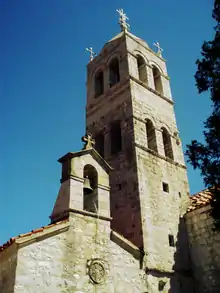
Andrija Mirosavljević was entitled to the governance of Hum, as the heir of Miroslav of Hum, the uncle of Stefan II, but the Hum nobles chose his brother Petar as Prince of Hum.[5] Petar exiled Andrija and Miroslav's widow (the sister of Ban Kulin of Bosnia), and Andrija fled to Rascia, to the court of Stefan II.[5] In the meantime, Petar fought successfully with neighbouring Bosnia and Croatia.[5] Stefan sided with Andrija and went to war and secured Hum and Popovo field for Andrija sometime after his accession.[5] Petar was defeated and crossed the Neretva, continuing to rule the west and north of the Neretva, which had in 1203 been briefly occupied by Andrew II of Hungary.[5] Stefan gave the titular and supreme rule of Hum to his son Radoslav, while Andrija held the district of Popovo with the coastal lands of Hum, including Ston.[5] By agreement, when Radoslav died, the lands were bound to Andrija.[5]
Đorđe of Zeta, in order to secure his lands from Stefan, accepted Venetian suzerainty, possibly in 1208.[6] Đorđe may have done this due to tensions between the two, although this must not be the case.[6] Venice, after the Fourth Crusade, tried to exert control of the Dalmatian ports, and managed in 1205 to submit Ragusa – Đorđe submitted to prevent that Venice claimed his ports of southern Dalmatia.[6]
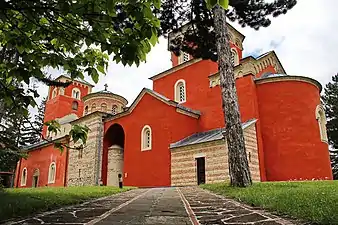
Đorđe promised Venice military aid in case of a revolt by another theoretical Venetian vassal, Dimitri, an Albanian Lord of Kruja.[6] This was likely related to the Rascia-Zeta conflict.[6] Stefan II married off his daughter,[6] Komnena, to Dimitri in 1208.[7] The marriage resulted in close ties and an alliance between Stefan and Dimitri amidst these conflicts.[6][7] Kruja is conquered by Epirote Despot Michael I Komnenos Doukas, and Dimitri is not heard of in any surviving sources.[7][8] After Dimitri's death, the lands are left to Komnena,[9] who soon married Greek-Albanian Gregorios Kamonas, who took power of Kruja,[10] strengthening relations with Serbia, which had after a Serbian assault on Scutari been weakened.[7][10] Đorđe disappears from sources, and Stefan II controls Zeta by 1216, probably through military action.[6] Stefan either put Zeta under his personal rule, or assigned it to his son Stefan Radoslav.[6] Zeta would from now on have no special status, and would be given to the heir apparent.[6]
Despot Michael I of Epirus conquered Skadar, and tried to press beyond, but was stopped by the Serbs and his murder by one of his servants in 1214 or 1215.[8] He was succeeded by his half-brother Theodore Komnenos Doukas.[8] Theodore took on a policy of aggressive expansion, and allied himself with Stefan II. Stefan Radoslav married Anna Doukaina Angelina, the daughter of Theodore.
Coronation and autocephaly

Having long wanted to call himself king, Stefan set about procuring a royal crown from the papacy. It is not clear what Stefan promised in regard to the status of the Catholic Church, which had numerous adherents in the western and coastal parts of his realm, but a papal legate finally arrived in 1217 and crowned Stefan. In 1217 Stefan Nemanjić declared his independence from Byzantium and was crowned as "King of all Serbian lands and the coastland".[11] The advance of the Catholic Church in Serbia did not last long but angered Serbian clergy. Many opposed Stefan's coronation, with Sava protesting by leaving Serbia and returning to Mount Athos. Later Serbian churchmen were also bothered by Stefan's relations with the papacy; while Stefan and Sava's contemporary Domentian wrote that the coronation was performed by a papal legate, a century later Theodosius the Hilandarian claimed that Stefan was crowned by Sava. The contradiction led some Serbian historians to conclude that Stefan underwent two coronations, first by the legate and in 1219 by Sava, but modern scholars tend to agree that only the former took place.[12]
Marriage, monastic vows, and death
Stefan was married, around 1186, to Eudokia Angelina, the youngest daughter of Alexius Angelus and Euphrosyne Doukaina Kamaterina. Eudokia was the niece of the current Byzantine Emperor Isaac II Angelus. Isaac II arranged the marriage. According to the Greek historian Nicetas Choniates, Stefan and Eudocia quarreled and separated, accusing one another of adultery, after June 1198. They had three sons and two daughters:
- King Stefan Radoslav, ruled 1228–1233
- King Stefan Vladislav I, ruled 1233–1243
- Archbishop Sava II (born Predislav, proclaimed Saint)
- Countess Komnena Nemanjić of Kruja
Stefan remarried in 1207/1208, his second wife was Anna Dandolo, granddaughter of Venetian doge Enrico Dandolo. They had one son and one daughter:
- King Stefan Uroš I, ruled 1243–1276

He built many fortresses including Maglič. At the end of his life, Stefan took the monastic vow under the name Symeon and died soon after. He was canonized as his father was.
Legacy
According to the legend there was a guest house on the road between Budva and Petrovac and a column in front of it with a wine vessel for thirsty passengers. According to this legend Stefan drank from this wine vessel during his visit to his cousin, Venetian Doge Dandolo.[13] Later, in 1223 or 1226, he allegedly built the Church of the Assumption of Mary (Serbian: Црква Успења Пресвете Богородице), thereby founding the Reževići Monastery.
In fiction
References
- Fine 1994, p. 94
- Curta, p. 385
- Velimirović, p. 61
- Андреев 2004, p. 180
- Fine 1994, p. 53
- Fine 1994, p. 50
- Rosamond McKitterick; David Abulafia (21 October 1999). The New Cambridge Medieval History: Volume 5, C.1198-c.1300. Cambridge University Press. p. 786. ISBN 978-0-521-36289-4.
- Fine 1994, p. 68
- The despotate of Epiros, p. 48
- The despotate of Epiros, p. 156
- Marie-Janine Calic; (2019) The Great Cauldron: A History of Southeastern Europe p. 38; Harvard University Press,ISBN 0674983920
- Fine, John Van Antwerp, Jr. (1994). The Late Medieval Balkans: A Critical Survey from the Late Twelfth Century to the Ottoman Conquest. Michigan: University of Michigan Press. ISBN 0-472-08260-4.
- Draško Šćekić (1987). Putujući Crnom Gorom. NIO "UR". p. 40. Retrieved 31 July 2013.
I ovdje nas čeka predanje. Ono kaže da je tu u doba Nemanjića postojala gostionica, ispred koje...
- Nedeljnik.rs, accessed on 15-Apr-17, http://www.nedeljnik.rs/magazin/portalnews/vojin-cetkovic-o-seriji-nemanjici-pitace-se-neki-zasto-su-nasi-kraljevi-jeli-zlatnim-viljuskama-i-kasikama/
- Blic Online, accessed on 15-Apr-17, http://www.blic.rs/zabava/vesti/blic-na-snimanju-nemanjica-vojin-cetkovic-za-ovu-ulogu-sam-se-spremao-ceo-zivot-video/hgzs8rb
Sources
- Fajfrić, Željko (2000) [1998], Sveta loza Stefana Nemanje, Belgrade: Tehnologije, izdavastvo, agencija Janus
- Fine, John Van Antwerp (1994) [1987]. The Late Medieval Balkans: A Critical Survey from the Late Twelfth Century to the Ottoman Conquest. Ann Arbor, Michigan: University of Michigan Press. ISBN 0-472-08260-4.
- Ćirković, Sima (2004). The Serbs. Malden: Blackwell Publishing.
- Ostrogorsky, George (1956). History of the Byzantine State. Oxford: Basil Blackwell.
- Kalić, Jovanka (2017). "The First Coronation Churches of Medieval Serbia". Balcanica. 48: 7–18.
- Serbia under Nemanićs
Further reading
- Popović, Danica (2013). "Када је Краљ Стефан Првовенчани уврштен у светитеље? Прилог проучавању владарске "канонизације" у средњовековној Србији" [When was king Stefan the first-crowned included among the saints? A contribution to the study of royal “canonization” in medieval Serbia]. Zbornik radova Vizantoloskog instituta. 50 (2): 573–585.
External links
| Wikimedia Commons has media related to Stefan the First-Crowned. |
- History of the Serb People – the Latin Empire and the creation of the Serb Kingdom by Vladimir Ćorović (in Serbian)
- The Holy bloodline of Stephen Nemanya by Željko Fajfrić (in Serbian)
Stefan the First-Crowned Born: around 1165 Died: 24 September 1228 | ||
| Regnal titles | ||
|---|---|---|
| Preceded by Stefan Nemanja |
Grand Prince of Serbia 1196–1202 |
Succeeded by Vukan |
| Preceded by Vukan |
Grand Prince of Serbia 1204–1217 |
Succeeded by title elevated→ |
| Preceded by ←title elevated |
King of Serbia 1217–1228 |
Succeeded by Radoslav |
